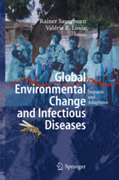
Global environmental change and infectious diseases: impacts and adaption strategies
Sauerborn, Rainer
Louis, Valérie R.
This book examines how man-made global environmental changes may affect infectious diseases. The authors look at six major global changes: climate change, the thinning of the ozone layer, soil degradation and changes in land use, water scarcity, loss of biodiversity and a degradation of ecosystems of the oceans. This holistic view of the impact of GEC is welcome for two reasons: firstly, the drivers of GEC interact and their effects are therefore difficult to separate and secondly, up until now the literature has focused on single driver views, particularly on the relationship between climate change and health. Mankind is not portrayed as passively enduring the consequences of its own behavior, but rather as perpetrator, victim and solver of the problems. Hence, the book also deals with adaptation opportunities and describes specific policy suggestions. Despite its name global change has very different effects locally andthere are large differences in the capacity of populations to protect themselves against negative health effects. The authors address inequities both in the environmental disturbances and in the health consequences. To tackle this task the editors have assembled an impressive group of authors from disciplines as diverse as biogeochemistry, geography, earth science, modelling, microbiology, medicine and epidemiology. However, the book remains very readable for a wide audience of teachers, scholars and interested lay people.Keywords » Biodiversity - Cholera - Climate Change - Diarrhoea - Geomedicine - Malaria - Ozone Hole - Pneumonia - Sars - Soil Degradation - Trachoma - Tropical Medicine - Water Protection
- ISBN: 978-3-540-38887-6
- Editorial: Springer
- Encuadernacion: Cartoné
- Páginas: 260
- Fecha Publicación: 01/11/2010
- Nº Volúmenes: 1
- Idioma: Inglés
